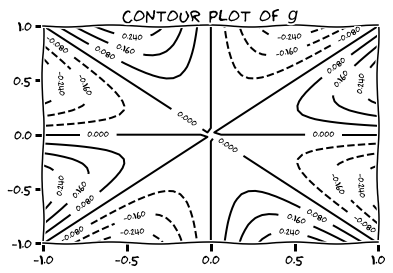MATH 524 Fall 2017 Chapter 1
Basic, Intermediate and CAS problems
-
Find and sketch the domain of the following functions.
- \( f(x,y) = \sqrt{y-x-2} \)
- \( f(x,y) = \log \big( x^2+y^2-4 \big) \)
- \( f(x,y) = \dfrac{(x-1)(y+2)}{(y-x)(y-x^3)} \)
- \( f(x,y) = \log (xy+x-y-1) \)
-
Find and sketch the level lines \( f(x,y)=c \) on the same set of coordinate axes for the given values of \( c \).
- \( f(x,y) = x+y-1, c \in \{ -3, -2, -1, 0, 1, 2, 3 \}. \)
- \( f(x,y) = x^2+y^2, c \in \{ 0, 1, 4, 9, 16, 25 \}. \)
- \( f(x,y) = xy, c \in \{ -9, -4, -1, 0, 1, 4, 9 \}. \)
-
Use a Computer Algebra System of your choice to produce contour plots of the given functions on the given domains.
- \( f(x,y) = (\cos x)(\cos y) e^{-\sqrt{x^2+y^2}/4} \) on \( [-2\pi, 2\pi] \times [-2\pi, 2\pi]. \)
- \( g(x,y) = \dfrac{xy(x^2-y^2)}{x^2+y^2} \) on \( [-1,1] \times [-1,1]. \)
- \( h(x,y) = y^2 - y^4 -x^2 \) on \( [-1,1]\times[-1,1] \).
- \( k(x,y) = e^{-y}\cos x \) on \( [-2\pi, 2\pi]\times[-2,0]. \)




-
Sketch the curve \( f(x,y)=c \) together with \( \nabla f \) and the tangent line at the given point \( P \). Write an equation for the tangent line.
- \( f(x,y)=x^2+y^2, c=4, P=(\sqrt{2}, \sqrt{2}). \)
- \( f(x,y)=x^2-y, c=1, P=(\sqrt{2}, 1). \)
- \( f(x,y)=xy, c=-1, P=(2, -1/2). \)
- \( f(x,y)=x^2-xy+y^2, c=7, P=(-1,2). \)
- For the function \( f(x,y) = \dfrac{x-y}{x+y} \) at the point \( P_0 = (-1/2, 3/2) \), find the directions \( \boldsymbol{v} \) and the directional derivatives \( D_{\boldsymbol{v}}f(P_0) \) for which
- \( D_{\boldsymbol{v}}f(P_0) \) is largest.
- \( D_{\boldsymbol{v}}f(P_0) \) is smallest.
- \( D_{\boldsymbol{v}}f(P_0) = 0. \)
- \( D_{\boldsymbol{v}}f(P_0) = 1. \)
- \( D_{\boldsymbol{v}}f(P_0) = -2. \)
-
The derivative of \( f(x,y) \) at \( (1,2) \) in the direction \( \frac{\sqrt{2}}{2}[1,1] \) is \( 2\sqrt{2} \) and in the direction \( [0,-1] \) is \( -3 \). What is the derivative of \( f \) in the direction \( \frac{\sqrt{5}}{5}[-1,-2] \)?
-
Find the absolute maxima and minima of the function \( f(x,y) = (4x-x^2)\cos y \) on the rectangular plate \( 1\leq x \leq 3, -\frac{\pi}{4} \leq y \leq \frac{\pi}{4}. \)
-
Find two numbers \( a \leq b \) such that \( \int_a^b (24-2x-x^2)^{1/3}\, dx \) has its largest value.
-
Find the points of the hyperbolic cylinder \( x^2-z^2-1=0 \) in \( \mathbb{R}^3 \) that are closest to the origin.
-
Find the extreme values of the function \( f(x,y,z)=xy+z^2 \) on the circle in which the plane \( y-x=0 \) intersects the sphere \( x^2+y^2+z^2=4. \)
-
Write a routine (in your favorite CAS) that uses symbolic computation to find the minimum of a differentiable real-valued function \( f \colon \mathbb{R} \to \mathbb{R} \) over
- a closed interval \( [a,b] \)
- An interval of the form \( [a,\infty) \), or \( (-\infty, b] \)
The routine should accept as input:
- the expression of the function \( f \),
- the endpoints \( a,b. \)